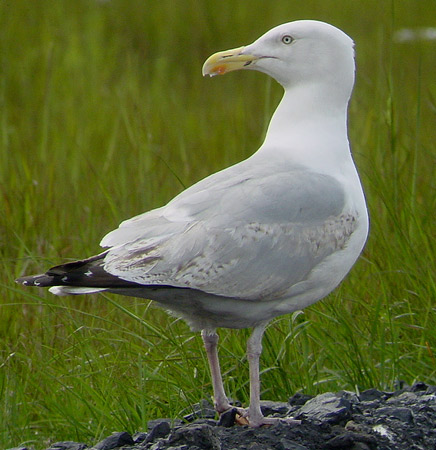 Herring
Gull - Zilvermeeuw (argentatus & argenteus): sub-adult May
Herring
Gull - Zilvermeeuw (argentatus & argenteus): sub-adult May
(last update: 08 december 2003)
Home
Links
to Gull Sites
Gull Taxa
Gull Topography
Grey & Colour Charts
Locations in NW Europe
Summaries of Articles
About ORG
@
Herring Gull sub-adult (argenteus), May 31 2002, EMO - Maasvlakte, the Netherlands (51.59N,04.02E).
Clearly a sub-adult bird (probably a male), nonetheless with a nest and two relatively large chicks. Compared to the surrounding Lesser Black-backed Gulls, this brood is doing well. Sub-adult Herring Gulls breeding in the colonies are not uncommon. The scapulars appear completely adult-like grey but in the wing-coverts and on the tertials many vermiculated brown-black markings are visible.
The primaries show a clear mirror on P10. Last autumn, this individual has replaced the all-brown immature primaries for more adult-like primaries, which show a white tip, a grey basal half and one or two mirrors (P9 and P10). But still the size of the dark patches and the amount of black in the outer primaries is more extensive when compared to adults: there is often a broad dark sub-terminal band on P5 and a dark faint spot on the outer-web of P4. The dark patches are not sharply demarcated as in adult, but the dark outer-web gradually dissolves in the grey inner-web.
From January to April, 4cy argenteus moult to so-called "third summer" plumage. By April, the head and under-parts appear all-white. The tail-feathers, wing-coverts and primaries are not replaced in this partial spring moult, therefore most birds strongly resemble "third winter" birds, although the white primary tips wear away and dark patches start to bleach. The iris turns bright yellow in many sub-adults, the orbital ring turns yellowish-orange and the bill will become predominantly yellow with a red gonydeal spot and limited black markings along the culmen by April.
During summer, from June onwards, a
complete moult takes place in argenteus, bringing birds in
so-called "adult winter" plumage. As long as the old outer third
generation primaries are visible (until August), ageing as 4cy argenteus
is rather straightforward. From November onwards, 4cy argenteus
much resembles adult birds, except that the bare parts still show immature
feathers: the black bill-band is obvious, extending over both upper and
lower mandible. On average, this plumage develops a more pronounced winter
'hood' than in full adults: dense streaking on head, especially around the
eye and in the hind-neck. The upper-parts, wing-coverts and tertials
appear adult-like grey from 4cy October onwards. The fourth generation
tail-feathers are plain white.
The new fourth generation primaries are similar to the adult primaries,
although the primary tips may appear slightly smaller, but otherwise
similar in pattern: grey inner-wing and black outer-wing. Both P9 and P10
show a mirror. P5 shows small black sub-terminal markings,
concentrated on the outer-web as a clear-cut black angular spot and rarely
extending on the inner-web as a diffuse streak. There may be some black on
P4 as well. Adult argenteus show a different pattern in the outer
primaries, compared to northern argentatus. In argentatus,
especially from northern Scandinavia, the black marking on P5 is very
limited and diffuse or this is sub-terminal markings are completely
lacking on P5.
Argenteus has more black in the outer primaries, including a black
band on the top of p10 in most birds, dividing the tip from the mirror. If
the black sub-terminal band on P10 is broken, the outer-web of p10 still
shows black marking. Argentatus normally lacks sub-terminal
markings on the outer-web of P10.
The scapular coverts are plain grey, lacking white crescents. The tertials
show obvious white tips. The iris is yellow. The bill is yellow with a red
gonydeal spot confined to the lower mandible. The orbital ring is
yellow-orange or orange-red. The legs are flesh-pink.
